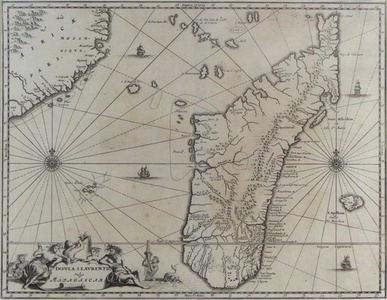| Method | Copper engraved |
| Artist | Dapper, Olfert |
| Published | [Jacob van Meurs, Amsterdam, 1670] |
| Dimensions | 282 x 365 mm |
| Notes |
A decorative map of the island of Madagascar, and the coastline of Mozambique, adorned with two compass roses, and four sailing ships, from the German edition of Dapper's Naukeurige Beschrijvinge der Afrikaensche Gewesten, commonly known as the Description of Africa. The title is featured in the lower left corner, set within a decorative cartouche, and surrounded by Poseidon and his nymphs. Madagascar's history is one of constant contact with and settlement by seafaring peoples. The original settlers of the island likely came from Borneo, and were followed by Arab merchants from the seventh century AD onwards. A group of Bantu speakers from East Africa arrived around 1000 AD, and sporadic European contact began following the Portuguese expedition of Diogo Dias in 1500. Dias, the brother of the famous Bartolomeu Dias, served as a clerk for Vasco de Gama, and also discovered the Cape Verde Islands. The island's strategic location off the coast of Africa, combined with the lucrative mercantile shipping channels to India and the Spice Islands, made it a haven for piracy, particularly at the end of the seventeenth century and contemporary with this map, when it became a critical refueling point on the so-called 'Pirate Round' for captains such as Thomas Tew, Henry Avery, William Kidd, and Adam Baldridge. The latter, having fled Jamaica wanted for murder, established a settlement on Ile Sainte-Marie to resupply pirates preying upon the lucrative Hajj-pilgrimage treasure ships of Arab and Mughal nobles. The success of Avery in particular encouraged a rapid proliferation in piratical activity off the coasts of Madagascar, giving rise to legends of a pirate utopia called Libertalia. Olfert Dapper's 'Description of Africa' was an ethnographic book which offered a detailed description of the parts of Africa known to Europeans in the mid-seventeenth century. Despite the work being regarded as one of the most important and detailed seventeenth-century publications on Africa, Dapper himself never actually visited the continent. Instead, he relied on the reports of Jesuit missionaries and Dutch explorers. The 'Description of Africa' was first published in 1668 by Jacob van Meurs in Amsterdam, with a second Dutch edition appearing in 1676. In 1670, a German translation of the publication was issued, and in the same year, an English translation, which is generally attributed to John Ogilby. A French edition was published in 1676, although it was not as true to the original as the other translations. Olfert Dapper (1636 - 1689) was a Dutch physician and writer. Despite never travelling outside of the Netherlands, Dapper was a writer of world history and geography. Condition: Vertical centre fold as issued. Time toning to sheet. Minor foxing to plate. Trimmed to plate on sides, as issued. |
| Framing | framed |
| Price | £300.00 |
| Stock ID | 44530 |

